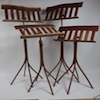So I tend to gravitate towards "character" wood, that will usually have some or many defects. Gluing up an end grain walnut and cherry cutting board, with some spectacular grain and "curlyness". Of course it's got a few cracks/checks/holes in it. These aren't very big. What I do is fill them in with black tinted epoxy. Again, these are small defects, but they're defects. Coming out of the drum sander, these boards look spectacular. The thing I'm worried about is, what, if any, are the safety concerns with the epoxy? I'm gifting these to folks with kids whom are pretty serious cooks, etc....emphasis on, no, I am not flooding the entire board with epoxy. Just filling in the very small defects. Finishing with the ubiquitous mineral oil and bees wax.




 Reply With Quote
Reply With Quote



